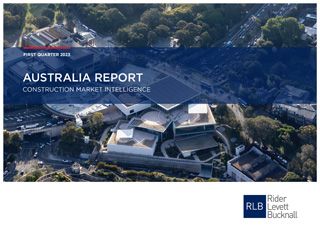According to Rider Levett Bucknall’s 1st Quarter 2023 Australia Report, the Australian construction industry is under pressure to deliver existing projects contracted under a very different set of circumstances that were evident two to three years ago.
Director Domenic Schiafone said, “Australia, like many other countries, has experienced sharp increases in construction escalation over the last two years. This has been due to a variety of factors, including sharp changes in material prices, labour costs, and other significant internal and external factors.”
Government fast tracking transport projects
One of these factors is the number of mega-projects currently under construction across Australia. Ten years ago, there was one transport infrastructure project (Brisbane’s Airport Link M7 and Northern Busway) in Australia worth more than $5 billion. Today there are nine.
Over the past three years, Australian governments have fast-tracked transport projects in the quest for an infrastructure-led recovery from the pandemic. These transport projects place pressure on the availability and cost of both material and labour resources, which filters down to all sectors.
Rise in construction costs putting pressure on developers
Domenic continued, “Construction in Australia continues in the midst of a perfect storm – these combined stresses are causing increased construction costs, project delays due to shortages of labour and materials, and reduced margins for contractors. The added rise in construction costs is placing pressure on developers who are struggling to align these increases with suitable rates of return, ultimately impacting project feasibility and delaying commencement of new projects.”
RLB’s Australia Report notes that alignment with the current economic challenges will see changes in the future workload and procurement methodologies adopted by both developers and contractors. Reputations and past performances will give way to more stringent solvency investigations and meticulous risk allocation in contracts.
Profitless boom causing companies to close their doors
Domenic added, “The industry is seeing a number of contractors going into insolvency. As project costs increase, pressure on the full supply chain increases. With the large number of projects under construction, a profitless boom is occurring, and more companies are closing their doors.”
Tender Price Index
Escalation forecasts of RLB’s offices indicate a slowing of the increases seen over the past two years, with 2022 being the peak rate of escalation for the majority of capital cities.
However, these increases remain higher than the decade averages previously seen across the country. While the volatility has dissipated, the risk of sudden cost surges remains, primarily due to influences that are seemingly beyond the construction industry’s control.
According to Domenic, “The end of the 2022 calendar year, and the start of 2023, have seen some cost inputs move the escalation needle a little to the left. Two of the highest profile escalation drivers—supply chain and material costs—appear to be stabilising.”
Supply chain pressures improving
“Overall supply chain pressures appear to be improving markedly. Overseas shipping and freight costs have been reducing towards pre-pandemic levels. In addition, the cessation of China’s zero-COVID policy has eased costs and delays associated with the major exporter’s ports,” he said.
While this has improved material availability, overall lead times are still longer than pre-COVID, and it appears that these timeframes will be entrenched moving forward. Domestically, regional, and remote areas are still facing logistical issues due to continuing fuel cost inflation, as well as a general lack of workers available in road transport.
Photo Credit: Aerial view of the Art Gallery of New South Wales’ new SANAA-designed building, 2022, photo © Iwan Baan
FURTHER INFORMATION:



